Farm & Ranch
[AgriLife Today] Texas barbecue owners, pitmasters learn about price trends at town hall meeting
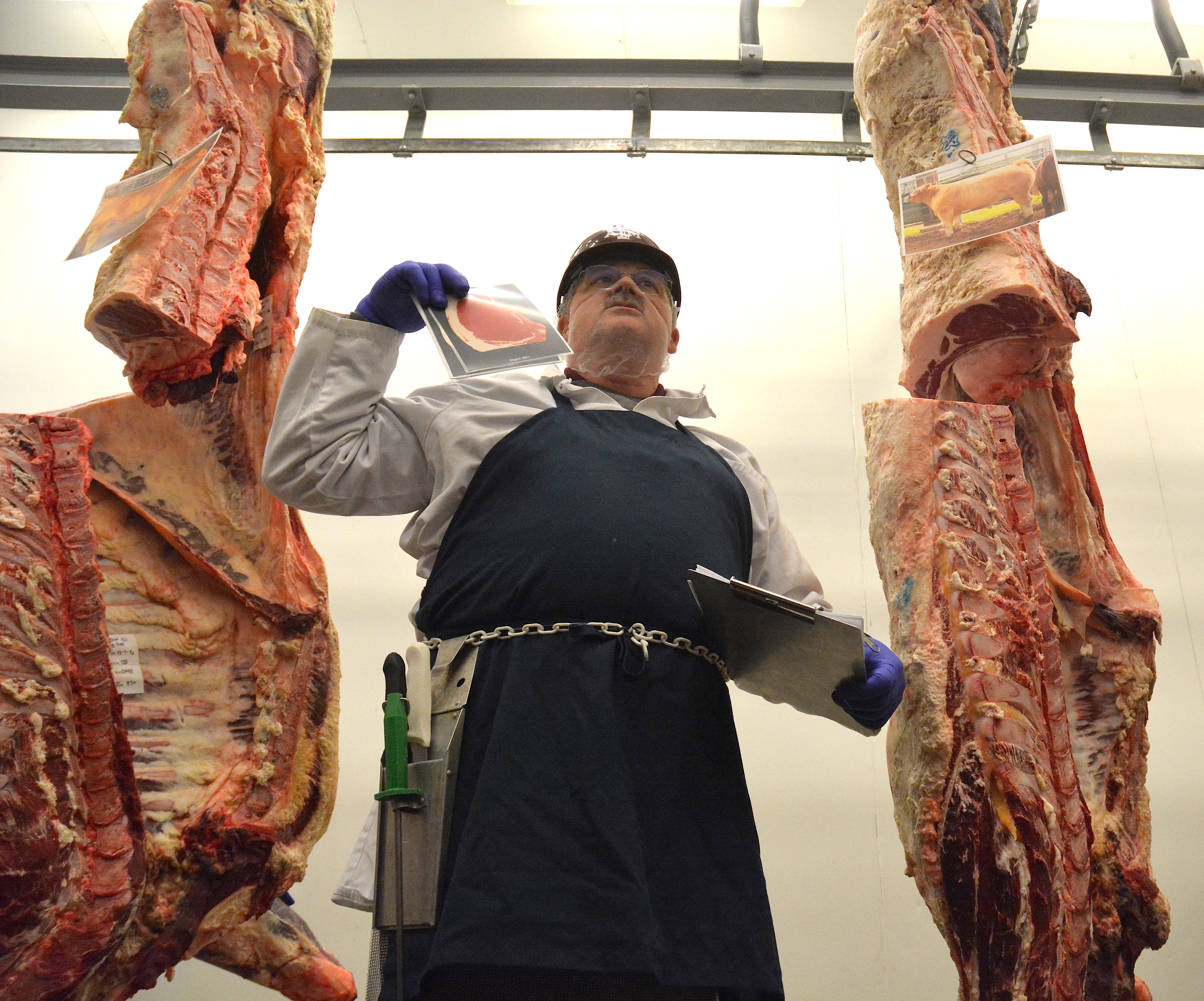
By: Blair Fannin
Beef, poultry, pork projected to continue record production levels
Writer: Blair Fannin, 979-845-2259, [email protected]
Contact: Dr. Jeff Savell, 979-845-3992, [email protected]
COLLEGE STATION – Record pounds of beef, pork and poultry produced in 2016 are projected to reach even higher in 2017, making Texas barbecue owners feel good about their prospects for satisfying hungry customers.
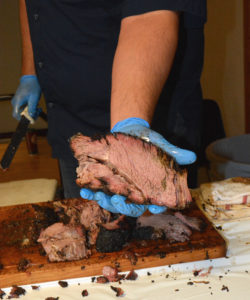
Evan LeRoy, pitmaster from Austin, cooked barbecue beef chuck roll for participants at the Texas Barbecue Town Hall meeting held at Texas A&M University in College Station. (Texas A&M AgriLife Extension Service photo by Blair Fannin)
“I think there will be more production of beef cows nationally and that will keep brisket prices down (as we head into 2017),“ said David Anderson, Texas A&M AgriLife Extension Service livestock economist, College Station. “We are coming off record cattle prices in 2015 and there’s expansion of the cow herd. With expansion comes lower prices.”
Texas barbecue restaurant owners and pitmasters heard Anderson give meat price and supply forecasts for 2017 at the recent Texas Barbecue Town Hall meeting at Texas A&M University in College Station. Dr. Kerri Gehring, associate professor of meat science in the animal science department, College Station, gave a food safety update.
The meeting, attended by 45 participants, was organized by Dr. Jeff Savell, university distinguished professor, Regents Professor and E.M. “Manny” Rosenthal chairholder in the department of animal science at Texas A&M in College Station. He was joined by Dr. Davey Griffin, AgriLife Extension meat specialist, and Ray Riley, manager of the Rosenthal Meat Center, both based in College Station, who led participants through a meat cooler, demonstrating carcass yield grades, barbecue beef cuts and potential carcass cuts that could be used as barbecue menu options.
“Last year we grew beef production by 3.5 percent,” Anderson said. “For 2017, we think we will have even more cows by the time the U.S. Department of Agriculture inventory report comes out in January.”
Low corn prices has helped feedlot operators add more gain. That, in turn, has led to higher levels of beef production and cheaper prices for wholesale brisket versus 2015 levels. Historic high cattle prices drove up prices for beef brisket, which in turn caused barbecue restaurant owners to raise their prices to offset their rising overhead costs.
Now that those prices have come down, it has helped improve bottom lines, but some participants still expressed concern.
“But if there’s a drought, all of this could get thrown out, right?” said Russell Roegel of Roegels Barbecue in Houston.
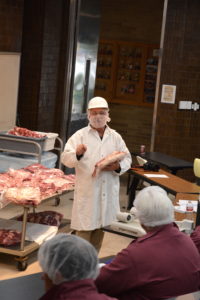
Dr. Jeff Savell, university distinguished professor, Regents Professor and E.M. “Manny” Rosenthal chairholder in the department of animal science at Texas A&M University, discusses beef cuts at the recent Texas Barbecue Town Hall meeting. (Texas A&M AgriLife Extension Service photo by Blair Fannin)
Anderson said, “If there’s a drought, but not widespread, it will certainly slow down the rate of growth in weight, but it wouldn’t be enough to slow down the trend we have right now of expansion.”
Kent Black of Black’s Barbecue in Lockhart wanted to know if corn prices would stay at or around current levels.
“I think so,” Anderson said. “To get a real big spike we would have to get a really big drought that was widespread. Cheap corn prices are going to feed further expansion.”
Evan LeRoy, pitmaster from Austin, cooked barbecue beef chuck roll and pork brisket for the town hall participants, which was a bit different than traditional barbecue, he said.
“I wanted to show that there are lots of other different barbecue cuts besides ribs and sausage,” LeRoy said.
To learn more about the Texas A&M barbecue program, visit bbq.tamu.edu .
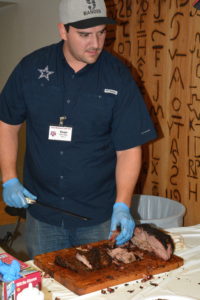
Evan LeRoy, pitmaster from Austin, cooked barbecue beef chuck roll and pork brisket for participants at the Texas Barbecue Town Hall meeting held at Texas A&M University in College Station. (Texas A&M AgriLife Extension Service photo by Blair Fannin)
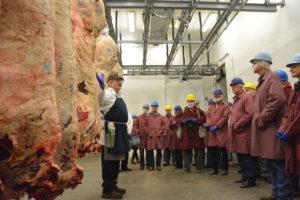
Dr. Davey Griffin, Texas A&M AgriLife Extension Service meat specialist, College Station, discusses beef yield grade and carcass cuts at the Texas Barbecue Town Hall meeting recently at Texas A&M University in College Station. (Texas A&M AgriLife Extension Service photo by Blair Fannin)
-30-
Find more stories, photos, videos and audio at http://today.agrilife.org
Farm & Ranch
Hazards of Backyard Poultry

By Barry Whitworth, DVM
Having backyard poultry is a popular agriculture enterprise. According to the United States Department of Agriculture, 0.8 percent of all households in the United States have chickens. People keep chickens for a variety of reasons with table eggs being one of the more common reasons.
Unfortunately, some of these poultry producers are not aware of the hazards that come with keeping poultry because many times they carry pathogens but appear healthy.
Chickens are carriers of several zoonotic diseases. These are diseases that can be passed from animals to humans. According to a recent survey in Pennsylvania, a majority of backyard poultry producers were aware of the dangers of avian influenza. However, this study also revealed that far fewer producers were aware of the risk of possible exposure to Salmonella and Campylobacter.
The lack of knowledge about the hazards of raising poultry likely contributes to the continued issues of Salmonella outbreaks associated with backyard poultry. In 2023, the Centers for Disease Control and Prevention reported 1,072 illnesses of Salmonella linked to backyard poultry, and 272 of those patients required hospitalization. Oklahoma reported 43 individuals with the disease.
To read more, pick up a copy of the April issue of NTFR magazine. To subscribe by mail, call 940-872-5922.
Farm & Ranch
Ag Elsewhere: Wyoming

By Tressa Lawrence
Babies are tucked away in every nook and cranny. Many ranchers across Wyoming have baby animals popping up all over this time of year.
Farm & Ranch
Ag Elsewhere: Montana

By Lindsey Monk
Another load of grain in to keep feeding the calves until the green grass can really start popping.
-

 Country Lifestyles1 year ago
Country Lifestyles1 year agoScott & Stacey Schumacher: A Growth Mindset
-

 Equine7 months ago
Equine7 months agoThe Will to Win
-

 Country Lifestyles7 years ago
Country Lifestyles7 years agoStyle Your Profile – What your style cowboy hat says about you and new trends in 2017
-

 Country Lifestyles4 years ago
Country Lifestyles4 years agoAmber Crawford, Breakaway Roper
-

 HOME7 years ago
HOME7 years agoGrazing North Texas – Wilman Lovegrass
-

 Country Lifestyles7 years ago
Country Lifestyles7 years agoDecember 2016 Profile, Rusty Riddle – The Riddle Way
-

 Country Lifestyles8 years ago
Country Lifestyles8 years agoJune 2016 Profile – The man behind the mic: Bob Tallman
-

 Outdoor9 years ago
Outdoor9 years agoButtercup or Primrose?






